
Aimst University M.B.B.S Community Medicine and District Health Office Posting
MBBS Batch 5&6 District Health Office Posting in Baling, Kedah Darul Aman
Week 2 (25/11/2007-29/11/2007)
Introduction
Hi again,
Let me once again bring you to our posting in Baling in the second week.
SUNDAY 25TH NOVEMBER 2007
We reported to Pejabat Kesihatan Daerah Baling to KJK Maznah Hussin. We were informed to help the other nurses to run a health campaign in Kampung Masjid Sera.
We helped the 4-hour-long campaign.
We assigned each other to various counters whereby we measured the height, weight, calculated the body mass index (BMI) , took blood pressure, checked blood glucose level and we counsel the patients.
In return, the villagers happily invited us to join in their local luncheon called kenduri.
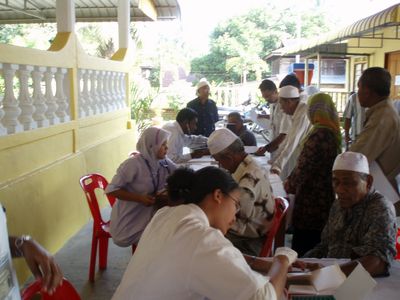
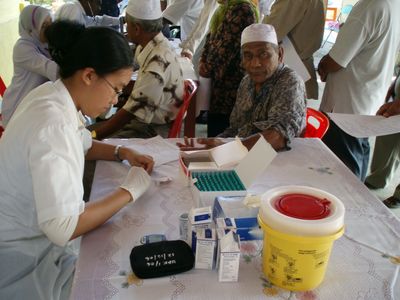
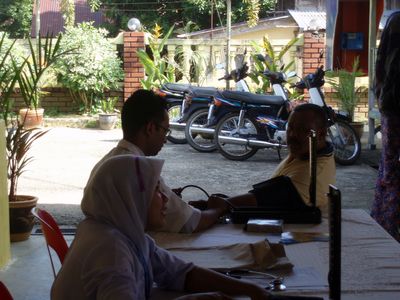
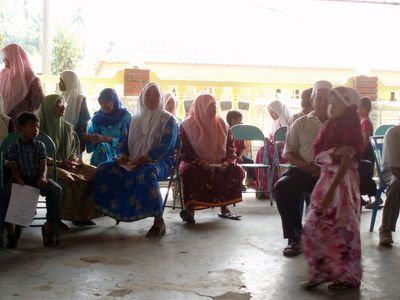
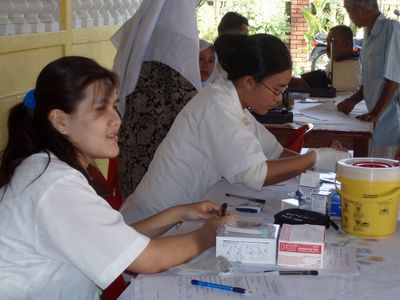
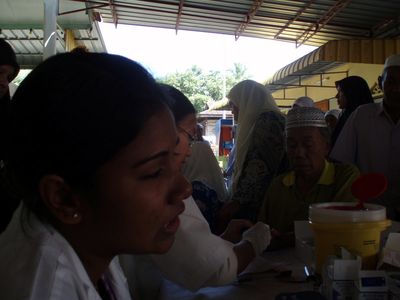
The above are some photos taken during the health campaign where we had participated in taking the blood pressure, measure the height and weight, calculating the BMI, getting the glucose results from a glucometer and advising the villagers on their diet control and how to lead a healthy lifestyle.
MONDAY 26TH NOVEMBER 2007
We began our day with a short introduction to communicable diseases of control (CDC) from PPKP Rosli Mansor and PPKP Lem Kiah Kwong.
We were then introduced to the Communicable Diseases Control Infection System (CDCIS) via an online system and were allowed to help the officer in charge register the new cases of communicable disease online.
In the afternoon, we proceeded to the Baling Hospital accompanied by PPKP Rosli Mansor to investigate a newly reported case of typhoid.
Next, we were brought to Kampung Muda where we observed the health officers collect samples of water and stools of family members. The members were also counseled regarding sanitation.
We then observed how the health officers sprayed sodium hypoclorite 10 % around infected areas.
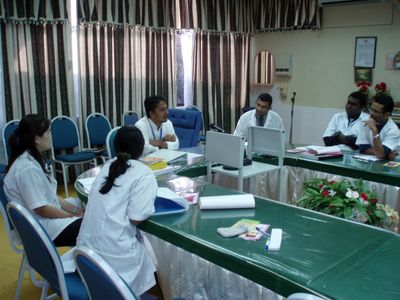
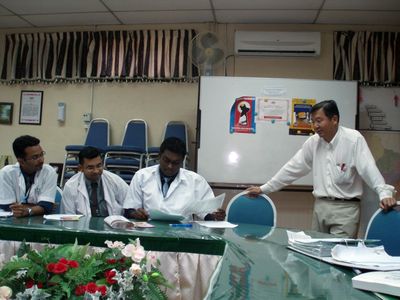
A brief introduction of Communicable Diseases of Control (CDC) were given by both PPKP En. Rosli and PPKP Mr. Lem. We were later being introduced the programme CDCIS (Communicable Diseases of Control Information System) by PPKP En. Rosli.
CDCIS
CDCIS is a online programme for the officers in charge to register the new cases of communicable diseases. Once the cases are registered, the cases can be reviewed by the higher health centres. By this, the number of cases in the whole of Malaysia which has been reported can be traced and pre-cautions can be taken before the communicable diseases spreads. CDCIS is also useful in the sense of keeping the records.
The cases will be notified by the doctors either in the Hospital or in the private sector. The doctors will called up the Health Office to notify them and povide them with necessary information.
There are 9 communicable cases which need to be notify within 24 hours. They are:-
- Dengue fever and Dengue Haemorrhagic fever
- Yellow fever
- Ebola
- Cholera
- Food Poisoning
- Plaque
- Rabies
- Polio
- Diphteria
The other communicable diseases can be notify within 1 week.
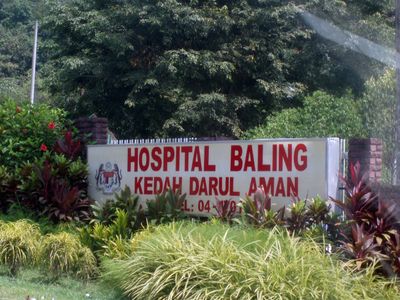
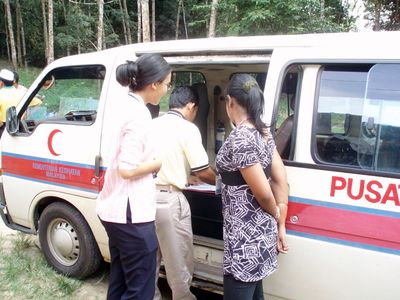
The above photos showed initially we went to the Baling Hospital as there was a typhoid case been reported. In the afternoon, we went to the resident of the patient who was suspected of typhoid.
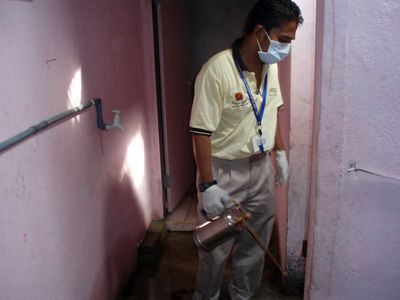
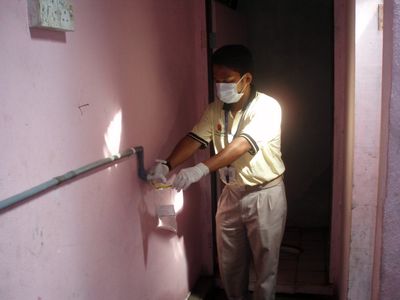
The left photo showed PPKP En. Rosli spraying sodium hypochlorite 10% around the breeding grounds. This is done to prevent the spread of the flies as the flies are the main vector for causing typhoid.
The right photo showing him again taking the sample of the water which will be sent to Penang Hospital for further investigations. It is learnt that the patient's resident uses 2 types of water (the JBA and the water from the hillside). Thus, samples of water were taken from the 2 water sources.
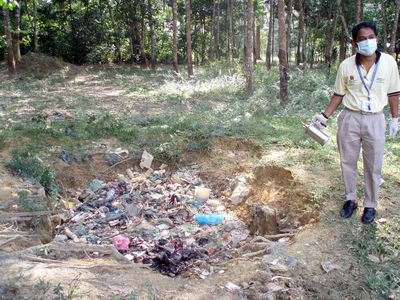
The last photo showed a large dug-up place where the villagers throw their rubbish.
TUESDAY 27TH NOVEMBER 2007
We arrived at Pusat Pengawalan Vektor daerah Baling in the morning and reported to PPKP Rozaidi Shamsudin and PPKP Abdullah Yusof.
Both the health officers gave a concise briefing regarding outbreak investigation.
We learned that Baling has the fourth highest dengue cases in Kedah recording 211 cases up till November 2007 following Kota Star, Kuala Muda and Kulim respectively.
We also learned how fogging for dengue infected areas, were carried out. Under normal circumstances, fogging would be done in a radius of 200m around the affected area.
The health officers also mentioned about other common outbreaks such as filariasis, malaria and Japanese Encephalitis.
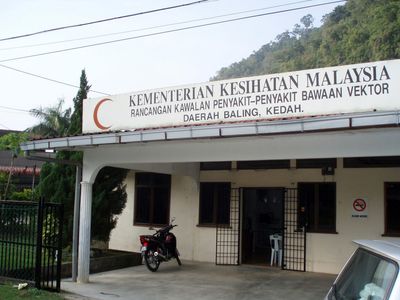
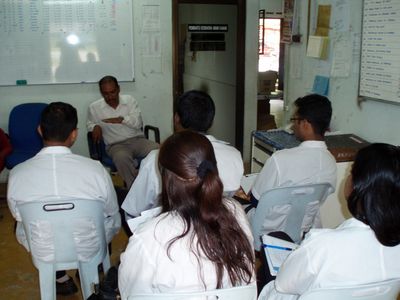
The photos showed the vector department where we were being given a brief idea of what the department do. Later we were told that there was a fogging session in the following week and we urged to follow and observed what they do. Over here, in this department, there is also a programme where they key in every cases noted. For example, if there is a case of dengue noted, they will sent out teams to do fogging. At the same time, they have the right to "saman" those houses where the breeding of mosquito is found. In the programme showed to us, each person who is been "saman" will be noted until they have pay the compound. If there is a case of suspected dengue noted, fogging will be done once. However, if there is a positive dengue case noted, the second time of fogging is taken place.
WEDNESDAY 28TH NOVEMBER 2007
A short briefing regarding non-communicable diseases was given by PPKP Cik Haslinda.
She explained that the non-communicable diseases covered by Pejabat Kesihatan Daerah Baling included diabetes, hypertension, cardiovascular diseases, family violence and others.
The Baling district is the pioneer for Blindness Programme ( Program Kebutaan). Another clinic set up by this district is "Quit Smoking" clinic.
PROSTAR is another branch of service provided by the district health office. It encompasses "Program Sihat untuk Remaja" . In this programme, teenagers between ages 13 to 25 years are educated and exposed to various health hazards such as obesity and diabetes, and are also introduced to healthy diet.
Finally, we were also informed of the yearly carnival that is held for 2 to 3 days long. This carnival includes a health campaign, blood screening, counseling and educational exhibitions. Its aim is to expose the public for primary prevention of diseases.
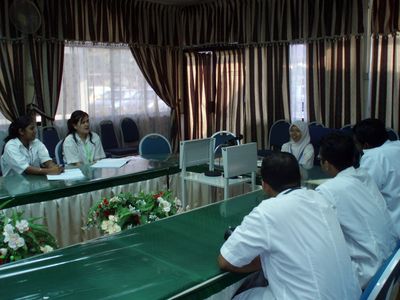
This photo showed us being brief of Non-Communicable Disease of Control (NCDC) by PPKP Cik Haslinda. At the same time, PROSTAR is also been introduced to us.
THURSDAY 29TH NOVEMBER 2007
The topic scheduled for the day was "Outbreak investigation" . PPKP Rosli Mansor briefed us on how a certain outbreaks such as food poisoning and cholera were tackled in Baling.
In terms of food poisoning, one episode is considered when one or more cases of similar symptoms develop in individuals. The definition of case in association with food poisoning includes an individual developing symptom or symptoms of food poisoning and receives treatment for these symptoms.
Epi-Info is a statistical table that the district health office forms to calculate whether the food consumed is significant to that particular episode of food poisoning. This data helps the health officers identify the true cause of food poisoning.
From the point of notification of case, the health officers would sent teams to clarify the cases with the affected individuals that include interviews to identify whether the symptoms suffered are due to food poisoning or a contribute of other factors. Once it has been clarified, then the patients and controls (those consumed the same food but are asymptomatic) are investigated. The final report concerning the outbreak of food poisoning is then sent to the health ministry at state level.
In terms of cholera outbreak, one case in one locality during one incubation period is considered a cholera outbreak.
Upon notification of case, and operation room (Bilik Gerakan) is formed. This unit consists of a health officer (Penolong Pegawai Kesihatan Perseketuan or PPKP), Control team, Investigation team, Case detection team and Health control unit.
The health officer is the head of the operation team. The functions of the control team include isolating and secluding sites and premises identified to be the source of outbreak. Such actions are carried out according to Act 1988. The investigation team identifies the affected individuals in the hospital and interviews them. Among the functions of case detection team is to collect samples from the alleged source of infection. The health control unit plans talks and exhibitions to educate the public regarding such outbreaks.
Upon the setting of the operation room, these teams are then sent to sites affected to carry out their respective responsibilities.
For an outbreak of cholera, the activities of patients are tracked 5 days prior to the onset of symptoms. The case detection team goes to the site to collect samples of rectal swabs and disinfection of areas are done with disinfectants such as sodium hypochlorite 10% or Lysol 1:10.

